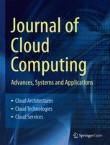Journal of Cloud Computing welcomes submissions to the thematic series on 'Machine learning algorithms for IoT services in big data and cloud computing'.
With an increasing number of devices connected to the internet, the volume of data generated and processed at greater speed has increased significantly, especially with the demand for action in real-time. With the increasing variety and veracity of data, such processing has become more challenging to achieve within a relevant time-frame. For these scenarios, the existing cloud infrastructure is a sub-optimal solution as the data generated are sent to various distant cloud centres. Integrating machine learning techniques into the existing cloud can therefore offer improved effectiveness.
There is also a very large amount of data stored in the cloud which can act as input for machine learning algorithms. A simple machine learning method such as clustering can organize and group different data together, after which other cognitive and predictive techniques can be used to improve outcomes. Data scientists have recently begun using various Machine Learning and Artificial Intelligence methods in cloud for efficient computing (examples include Amazon Web Services with Keras, IBM Watson, and Microsoft Cognitive AI).
Furthermore, in this era of IoT, Big Data Analytics and Blockchain almost all of the data are processed in the Cloud, and Machine Learning and Artificial Intelligence play a prime role in satisfying the demand for effective and efficient computing.
Given the various innovations and challenges for the existing cloud system to integrate ML and AI, we call on all researchers in this field to contribute to this special issue.
Potential topics include but are not limited to:
• Nature-Inspired smart hybrid systems for IoT context-aware systems
• Knowledge-Based discovery with evolutionary algorithms for QoS in IoT devices
• Meta-Heuristic algorithms for IoT and cloud computing
• Big Data analytics, machine learning algorithms and scalable/parallel/distributed algorithms, and computing for the IoT
• Innovative Cloud Infrastructure for Big Data
• Big Data for Cloud-assisted, IoT-based Cyber-Physical Systems
• Security models for cloud computing and the Internet of Things
• Big Data architectures for large-scale context-aware applications
• Context-aware dynamic decision making on streaming Big Data
• IoT platforms, architectures, and protocols supporting Big Data
• Distributed computing, data fusion, and aggregation over large-scale IoT deployments
• Cloud Computing as infrastructure in supporting IoT, Big Data Analytics and cyber physical systems.
• Deep learning and Artificial neural network for optimizing big data
• Heterogeneous computing for Big Data architecture
Submission instructions
Before submitting your manuscript, please ensure you have carefully read the submission guidelines for Journal of Cloud Computing. The complete manuscript should be submitted through the Journal of Cloud Computing submission system. To ensure that you submit to the correct thematic series please select the appropriate special issue in the drop-down menu upon submission. All submissions will undergo rigorous peer review and accepted articles will be published within the journal as a collection.
Lead guest editor:
Anand Paul, The School of Computer Science and Engineering, Kyungpook National University, South Korea
Guest editors:
Naveen Chilamkurti, La Trobe University, Melbourne, Australia
Ching-Hsien (Robert) Hsu, Department of Computer Science, National Chung Cheng University, Taiwan
Submissions will also benefit from the usual advantages of open access publication:
- Rapid publication: Online submission, electronic peer review and production make the process of publishing your article simple and efficient
- High visibility and international readership in your field: Open access publication ensures high visibility and maximum exposure for your work - anyone with online access can read your article
- No space constraints: Publishing online means unlimited space for figures, extensive data and video footage
- Authors retain copyright, licensing the article under a Creative Commons license: articles can be freely redistributed and reused as long as the article is correctly attributed.
